Corporate Accounting Report: Lease Accounting Standards
VerifiedAdded on 2021/06/16
|7
|1340
|19
Report
AI Summary
This report delves into the realm of corporate accounting, with a specific focus on lease accounting, primarily governed by the International Accounting Standard (IAS) 17. The introduction provides context by defining operating and financial leases, highlighting the classification requirements for reporting entities, and mentioning the impending shift to IFRS 16. The discussion section dissects the objectives of IAS 17, its applicability, and the accounting treatments for both lessors and lessees. It addresses disclosures related to financial and operating leases, detailing the required reconciliations, asset valuations, and recognition of contingent rents and minimum lease payments. Furthermore, it covers disclosure requirements for operating lessees and lessors, including the presentation of minimum lease payments and contingent rents. The report concludes by summarizing the initial and subsequent recognition of finance and operating leases, emphasizing the lessor's approach to allocating financial income and recognizing sales profits or losses. It also touches upon the recognition of costs incurred during lease negotiations by manufacturers and dealers. The report provides an overview of the key elements of lease accounting under IAS 17 and the associated disclosure requirements.
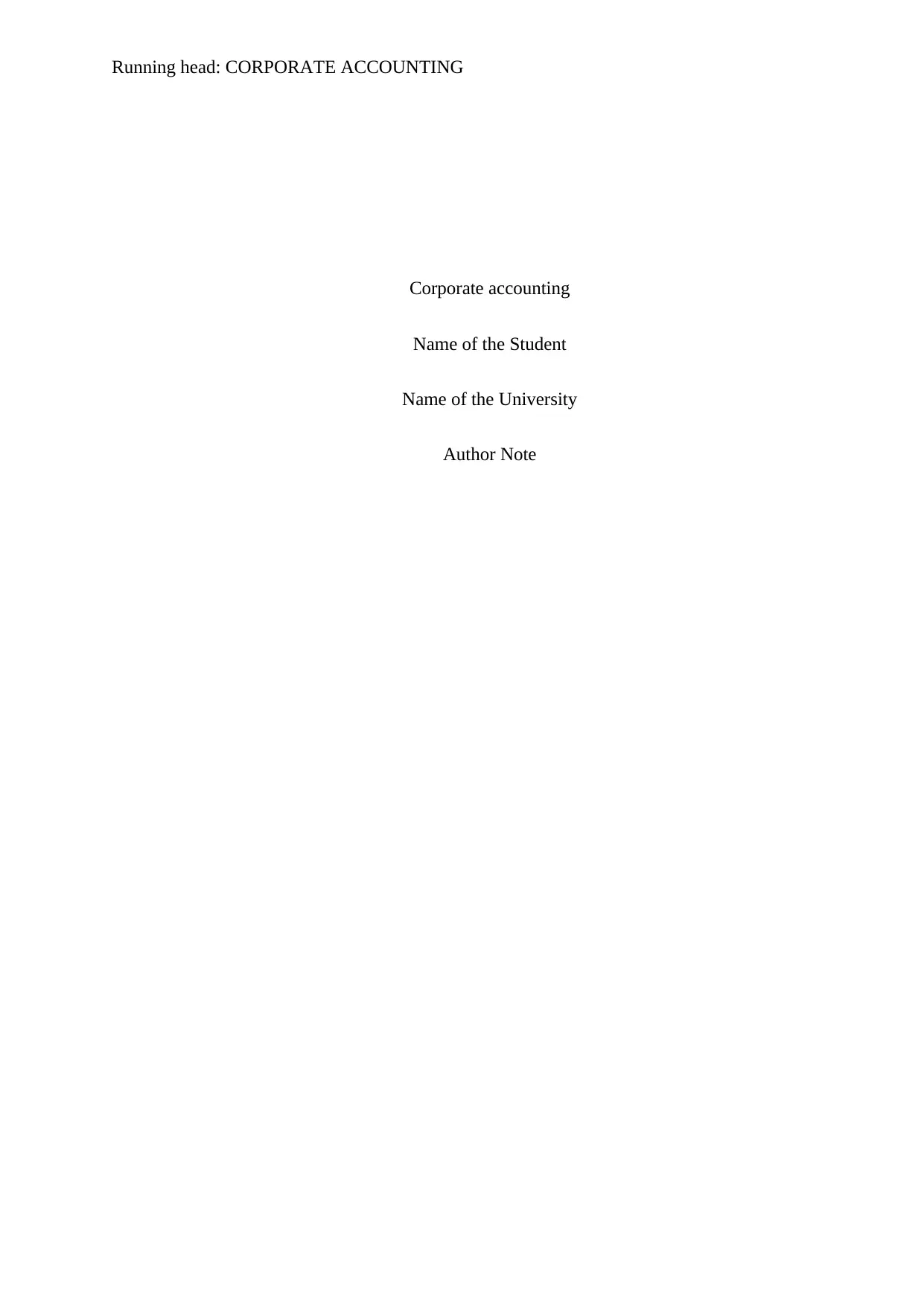
Running head: CORPORATE ACCOUNTING
Corporate accounting
Name of the Student
Name of the University
Author Note
Corporate accounting
Name of the Student
Name of the University
Author Note
Paraphrase This Document
Need a fresh take? Get an instant paraphrase of this document with our AI Paraphraser
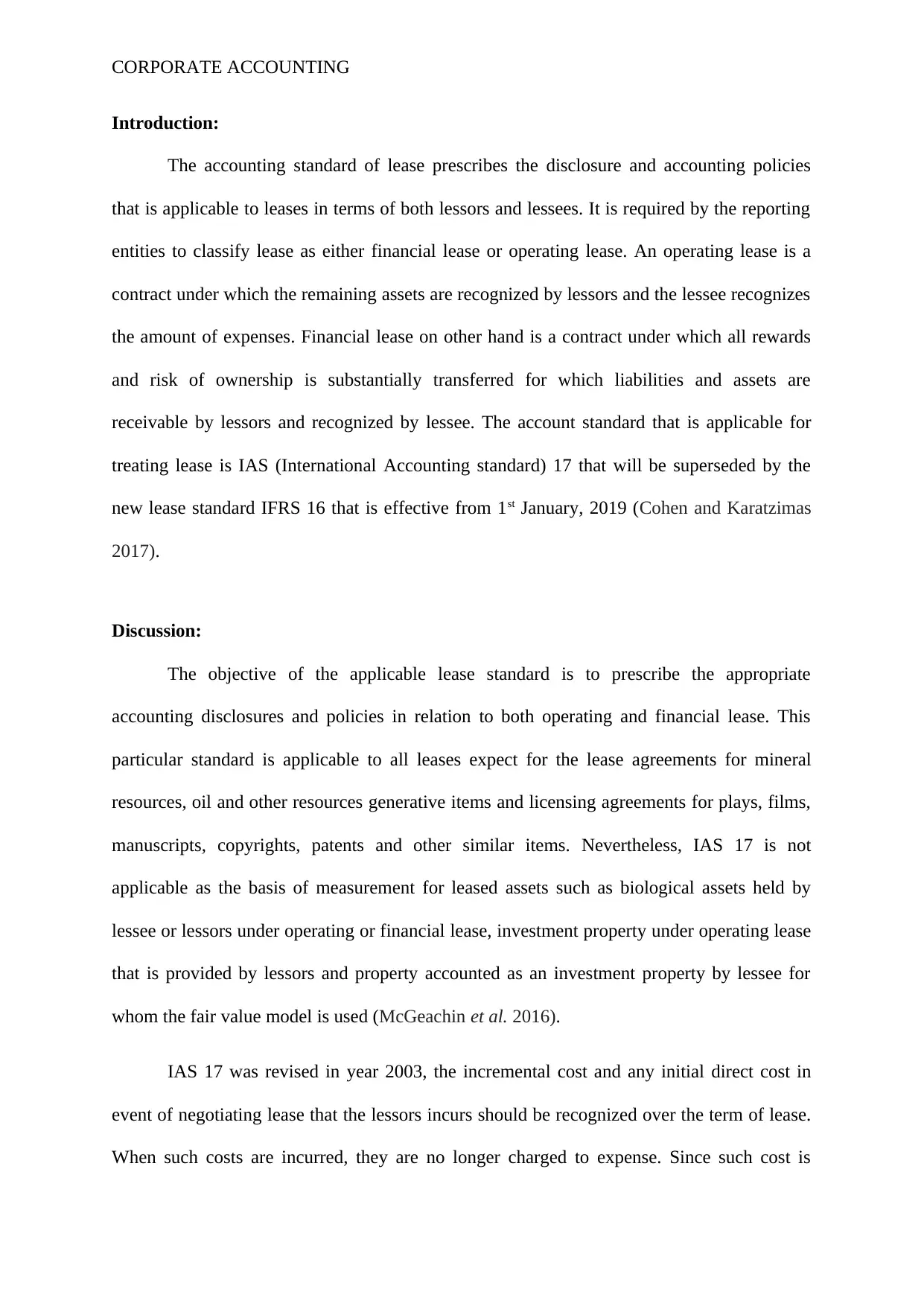
CORPORATE ACCOUNTING
Introduction:
The accounting standard of lease prescribes the disclosure and accounting policies
that is applicable to leases in terms of both lessors and lessees. It is required by the reporting
entities to classify lease as either financial lease or operating lease. An operating lease is a
contract under which the remaining assets are recognized by lessors and the lessee recognizes
the amount of expenses. Financial lease on other hand is a contract under which all rewards
and risk of ownership is substantially transferred for which liabilities and assets are
receivable by lessors and recognized by lessee. The account standard that is applicable for
treating lease is IAS (International Accounting standard) 17 that will be superseded by the
new lease standard IFRS 16 that is effective from 1st January, 2019 (Cohen and Karatzimas
2017).
Discussion:
The objective of the applicable lease standard is to prescribe the appropriate
accounting disclosures and policies in relation to both operating and financial lease. This
particular standard is applicable to all leases expect for the lease agreements for mineral
resources, oil and other resources generative items and licensing agreements for plays, films,
manuscripts, copyrights, patents and other similar items. Nevertheless, IAS 17 is not
applicable as the basis of measurement for leased assets such as biological assets held by
lessee or lessors under operating or financial lease, investment property under operating lease
that is provided by lessors and property accounted as an investment property by lessee for
whom the fair value model is used (McGeachin et al. 2016).
IAS 17 was revised in year 2003, the incremental cost and any initial direct cost in
event of negotiating lease that the lessors incurs should be recognized over the term of lease.
When such costs are incurred, they are no longer charged to expense. Since such cost is
Introduction:
The accounting standard of lease prescribes the disclosure and accounting policies
that is applicable to leases in terms of both lessors and lessees. It is required by the reporting
entities to classify lease as either financial lease or operating lease. An operating lease is a
contract under which the remaining assets are recognized by lessors and the lessee recognizes
the amount of expenses. Financial lease on other hand is a contract under which all rewards
and risk of ownership is substantially transferred for which liabilities and assets are
receivable by lessors and recognized by lessee. The account standard that is applicable for
treating lease is IAS (International Accounting standard) 17 that will be superseded by the
new lease standard IFRS 16 that is effective from 1st January, 2019 (Cohen and Karatzimas
2017).
Discussion:
The objective of the applicable lease standard is to prescribe the appropriate
accounting disclosures and policies in relation to both operating and financial lease. This
particular standard is applicable to all leases expect for the lease agreements for mineral
resources, oil and other resources generative items and licensing agreements for plays, films,
manuscripts, copyrights, patents and other similar items. Nevertheless, IAS 17 is not
applicable as the basis of measurement for leased assets such as biological assets held by
lessee or lessors under operating or financial lease, investment property under operating lease
that is provided by lessors and property accounted as an investment property by lessee for
whom the fair value model is used (McGeachin et al. 2016).
IAS 17 was revised in year 2003, the incremental cost and any initial direct cost in
event of negotiating lease that the lessors incurs should be recognized over the term of lease.
When such costs are incurred, they are no longer charged to expense. Since such cost is
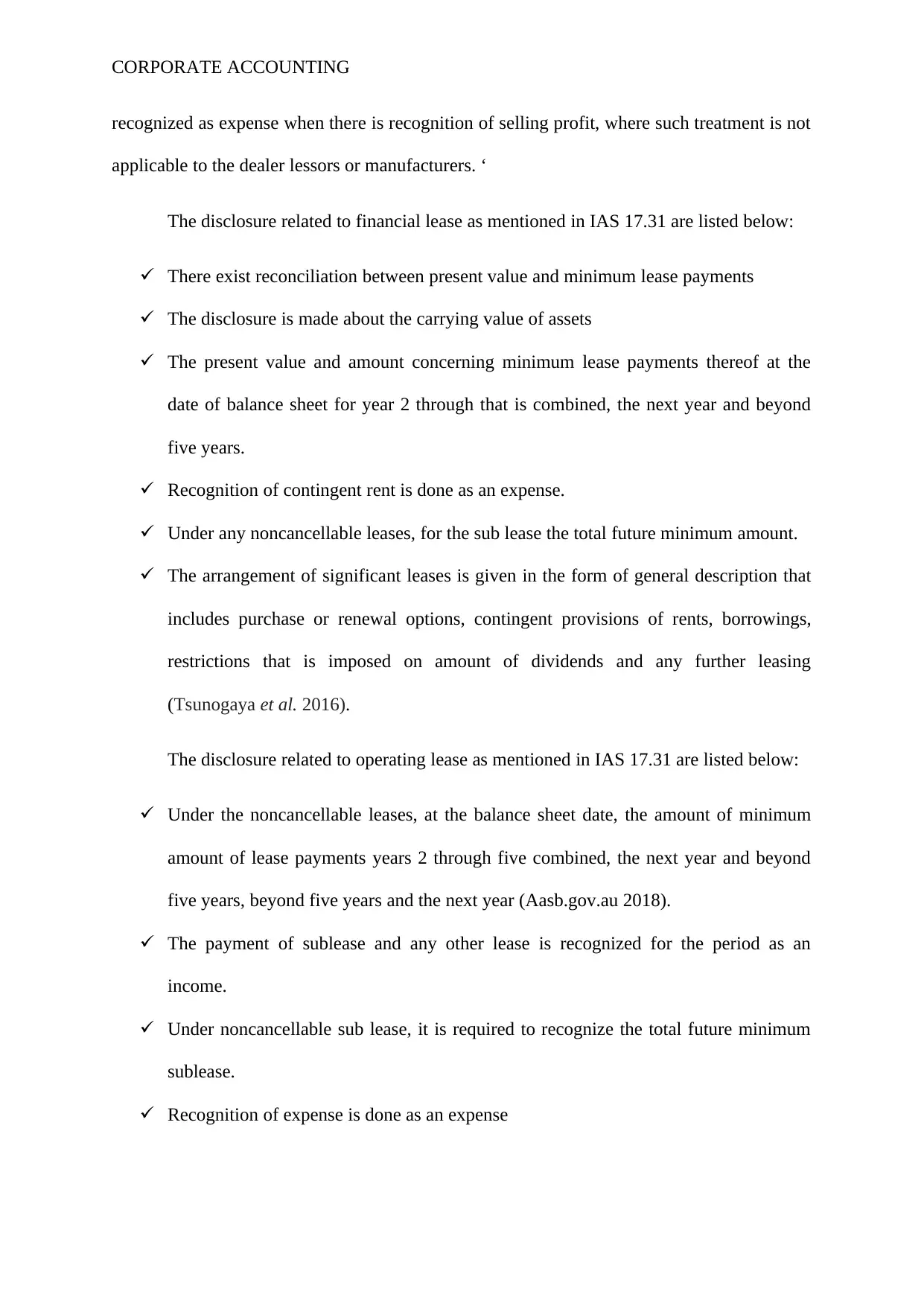
CORPORATE ACCOUNTING
recognized as expense when there is recognition of selling profit, where such treatment is not
applicable to the dealer lessors or manufacturers. ‘
The disclosure related to financial lease as mentioned in IAS 17.31 are listed below:
There exist reconciliation between present value and minimum lease payments
The disclosure is made about the carrying value of assets
The present value and amount concerning minimum lease payments thereof at the
date of balance sheet for year 2 through that is combined, the next year and beyond
five years.
Recognition of contingent rent is done as an expense.
Under any noncancellable leases, for the sub lease the total future minimum amount.
The arrangement of significant leases is given in the form of general description that
includes purchase or renewal options, contingent provisions of rents, borrowings,
restrictions that is imposed on amount of dividends and any further leasing
(Tsunogaya et al. 2016).
The disclosure related to operating lease as mentioned in IAS 17.31 are listed below:
Under the noncancellable leases, at the balance sheet date, the amount of minimum
amount of lease payments years 2 through five combined, the next year and beyond
five years, beyond five years and the next year (Aasb.gov.au 2018).
The payment of sublease and any other lease is recognized for the period as an
income.
Under noncancellable sub lease, it is required to recognize the total future minimum
sublease.
Recognition of expense is done as an expense
recognized as expense when there is recognition of selling profit, where such treatment is not
applicable to the dealer lessors or manufacturers. ‘
The disclosure related to financial lease as mentioned in IAS 17.31 are listed below:
There exist reconciliation between present value and minimum lease payments
The disclosure is made about the carrying value of assets
The present value and amount concerning minimum lease payments thereof at the
date of balance sheet for year 2 through that is combined, the next year and beyond
five years.
Recognition of contingent rent is done as an expense.
Under any noncancellable leases, for the sub lease the total future minimum amount.
The arrangement of significant leases is given in the form of general description that
includes purchase or renewal options, contingent provisions of rents, borrowings,
restrictions that is imposed on amount of dividends and any further leasing
(Tsunogaya et al. 2016).
The disclosure related to operating lease as mentioned in IAS 17.31 are listed below:
Under the noncancellable leases, at the balance sheet date, the amount of minimum
amount of lease payments years 2 through five combined, the next year and beyond
five years, beyond five years and the next year (Aasb.gov.au 2018).
The payment of sublease and any other lease is recognized for the period as an
income.
Under noncancellable sub lease, it is required to recognize the total future minimum
sublease.
Recognition of expense is done as an expense
⊘ This is a preview!⊘
Do you want full access?
Subscribe today to unlock all pages.

Trusted by 1+ million students worldwide
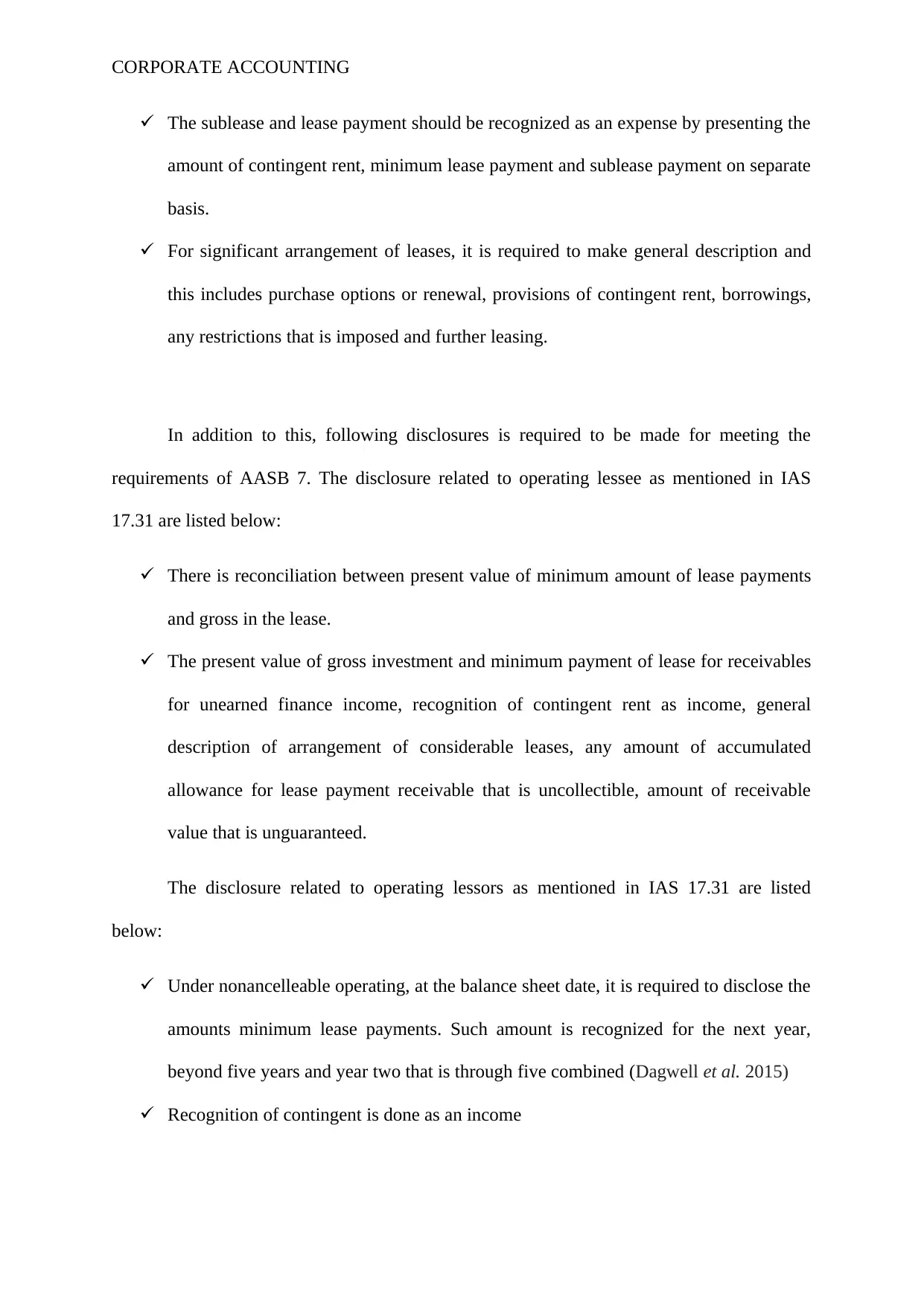
CORPORATE ACCOUNTING
The sublease and lease payment should be recognized as an expense by presenting the
amount of contingent rent, minimum lease payment and sublease payment on separate
basis.
For significant arrangement of leases, it is required to make general description and
this includes purchase options or renewal, provisions of contingent rent, borrowings,
any restrictions that is imposed and further leasing.
In addition to this, following disclosures is required to be made for meeting the
requirements of AASB 7. The disclosure related to operating lessee as mentioned in IAS
17.31 are listed below:
There is reconciliation between present value of minimum amount of lease payments
and gross in the lease.
The present value of gross investment and minimum payment of lease for receivables
for unearned finance income, recognition of contingent rent as income, general
description of arrangement of considerable leases, any amount of accumulated
allowance for lease payment receivable that is uncollectible, amount of receivable
value that is unguaranteed.
The disclosure related to operating lessors as mentioned in IAS 17.31 are listed
below:
Under nonancelleable operating, at the balance sheet date, it is required to disclose the
amounts minimum lease payments. Such amount is recognized for the next year,
beyond five years and year two that is through five combined (Dagwell et al. 2015)
Recognition of contingent is done as an income
The sublease and lease payment should be recognized as an expense by presenting the
amount of contingent rent, minimum lease payment and sublease payment on separate
basis.
For significant arrangement of leases, it is required to make general description and
this includes purchase options or renewal, provisions of contingent rent, borrowings,
any restrictions that is imposed and further leasing.
In addition to this, following disclosures is required to be made for meeting the
requirements of AASB 7. The disclosure related to operating lessee as mentioned in IAS
17.31 are listed below:
There is reconciliation between present value of minimum amount of lease payments
and gross in the lease.
The present value of gross investment and minimum payment of lease for receivables
for unearned finance income, recognition of contingent rent as income, general
description of arrangement of considerable leases, any amount of accumulated
allowance for lease payment receivable that is uncollectible, amount of receivable
value that is unguaranteed.
The disclosure related to operating lessors as mentioned in IAS 17.31 are listed
below:
Under nonancelleable operating, at the balance sheet date, it is required to disclose the
amounts minimum lease payments. Such amount is recognized for the next year,
beyond five years and year two that is through five combined (Dagwell et al. 2015)
Recognition of contingent is done as an income
Paraphrase This Document
Need a fresh take? Get an instant paraphrase of this document with our AI Paraphraser
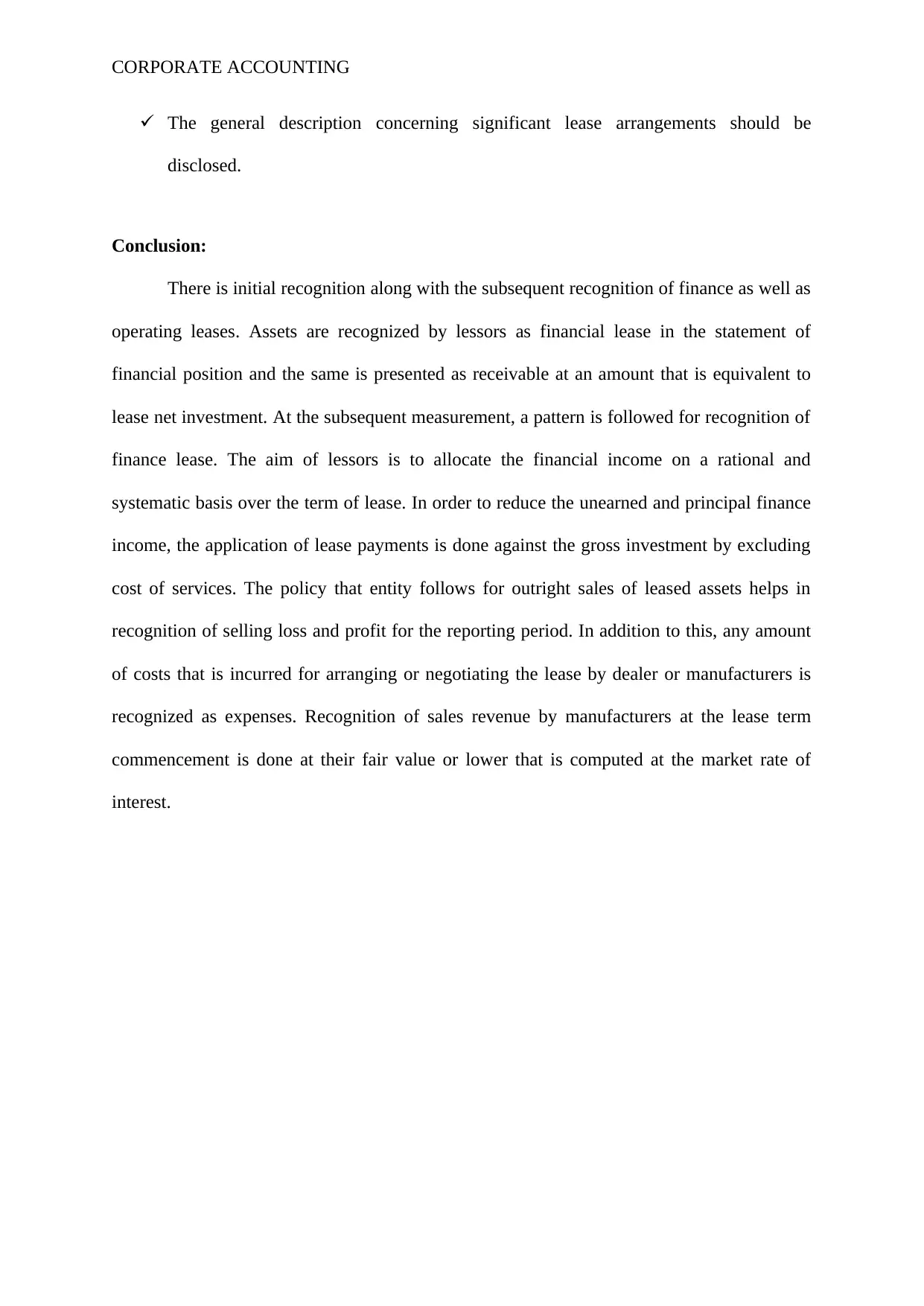
CORPORATE ACCOUNTING
The general description concerning significant lease arrangements should be
disclosed.
Conclusion:
There is initial recognition along with the subsequent recognition of finance as well as
operating leases. Assets are recognized by lessors as financial lease in the statement of
financial position and the same is presented as receivable at an amount that is equivalent to
lease net investment. At the subsequent measurement, a pattern is followed for recognition of
finance lease. The aim of lessors is to allocate the financial income on a rational and
systematic basis over the term of lease. In order to reduce the unearned and principal finance
income, the application of lease payments is done against the gross investment by excluding
cost of services. The policy that entity follows for outright sales of leased assets helps in
recognition of selling loss and profit for the reporting period. In addition to this, any amount
of costs that is incurred for arranging or negotiating the lease by dealer or manufacturers is
recognized as expenses. Recognition of sales revenue by manufacturers at the lease term
commencement is done at their fair value or lower that is computed at the market rate of
interest.
The general description concerning significant lease arrangements should be
disclosed.
Conclusion:
There is initial recognition along with the subsequent recognition of finance as well as
operating leases. Assets are recognized by lessors as financial lease in the statement of
financial position and the same is presented as receivable at an amount that is equivalent to
lease net investment. At the subsequent measurement, a pattern is followed for recognition of
finance lease. The aim of lessors is to allocate the financial income on a rational and
systematic basis over the term of lease. In order to reduce the unearned and principal finance
income, the application of lease payments is done against the gross investment by excluding
cost of services. The policy that entity follows for outright sales of leased assets helps in
recognition of selling loss and profit for the reporting period. In addition to this, any amount
of costs that is incurred for arranging or negotiating the lease by dealer or manufacturers is
recognized as expenses. Recognition of sales revenue by manufacturers at the lease term
commencement is done at their fair value or lower that is computed at the market rate of
interest.
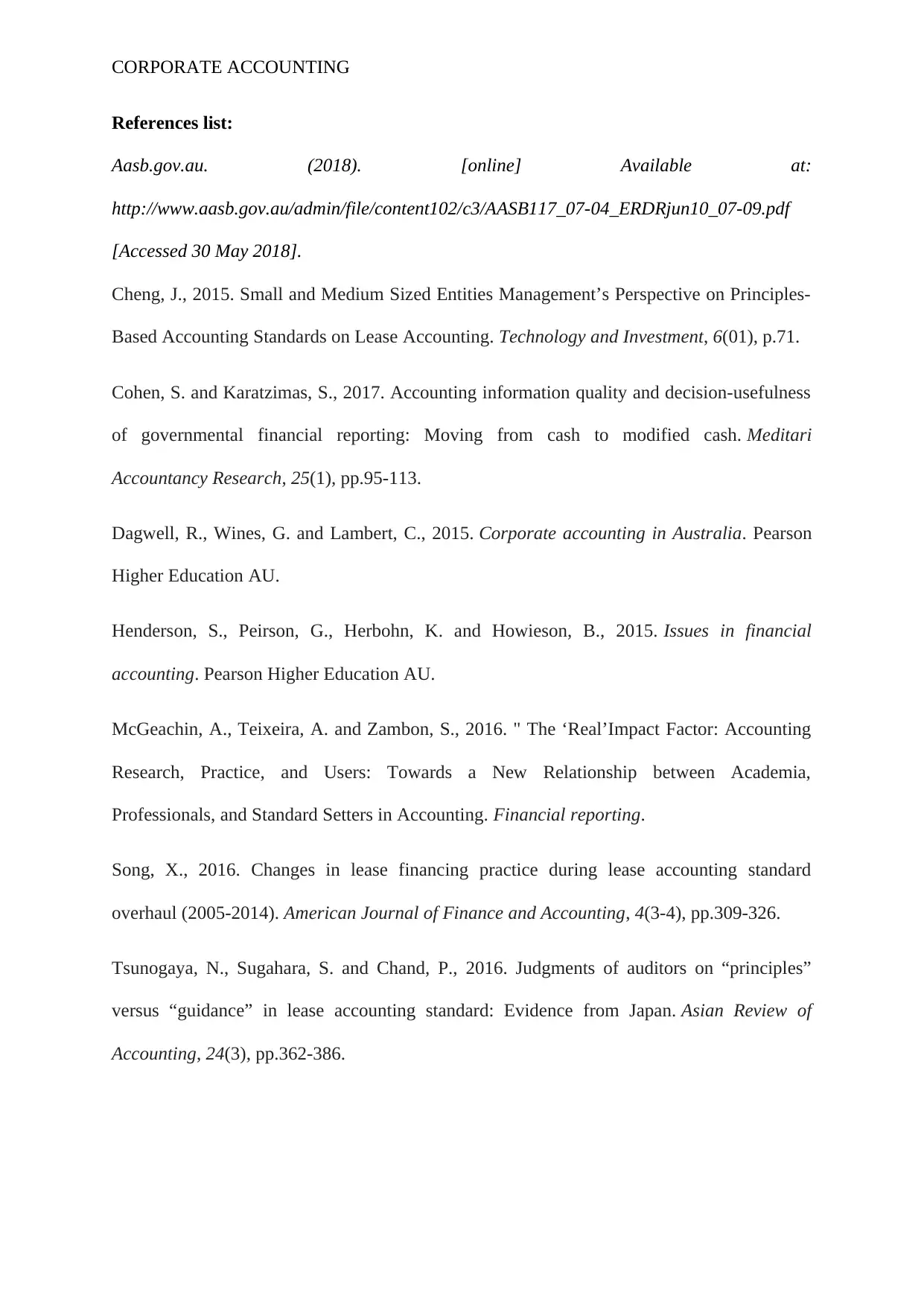
CORPORATE ACCOUNTING
References list:
Aasb.gov.au. (2018). [online] Available at:
http://www.aasb.gov.au/admin/file/content102/c3/AASB117_07-04_ERDRjun10_07-09.pdf
[Accessed 30 May 2018].
Cheng, J., 2015. Small and Medium Sized Entities Management’s Perspective on Principles-
Based Accounting Standards on Lease Accounting. Technology and Investment, 6(01), p.71.
Cohen, S. and Karatzimas, S., 2017. Accounting information quality and decision-usefulness
of governmental financial reporting: Moving from cash to modified cash. Meditari
Accountancy Research, 25(1), pp.95-113.
Dagwell, R., Wines, G. and Lambert, C., 2015. Corporate accounting in Australia. Pearson
Higher Education AU.
Henderson, S., Peirson, G., Herbohn, K. and Howieson, B., 2015. Issues in financial
accounting. Pearson Higher Education AU.
McGeachin, A., Teixeira, A. and Zambon, S., 2016. " The ‘Real’Impact Factor: Accounting
Research, Practice, and Users: Towards a New Relationship between Academia,
Professionals, and Standard Setters in Accounting. Financial reporting.
Song, X., 2016. Changes in lease financing practice during lease accounting standard
overhaul (2005-2014). American Journal of Finance and Accounting, 4(3-4), pp.309-326.
Tsunogaya, N., Sugahara, S. and Chand, P., 2016. Judgments of auditors on “principles”
versus “guidance” in lease accounting standard: Evidence from Japan. Asian Review of
Accounting, 24(3), pp.362-386.
References list:
Aasb.gov.au. (2018). [online] Available at:
http://www.aasb.gov.au/admin/file/content102/c3/AASB117_07-04_ERDRjun10_07-09.pdf
[Accessed 30 May 2018].
Cheng, J., 2015. Small and Medium Sized Entities Management’s Perspective on Principles-
Based Accounting Standards on Lease Accounting. Technology and Investment, 6(01), p.71.
Cohen, S. and Karatzimas, S., 2017. Accounting information quality and decision-usefulness
of governmental financial reporting: Moving from cash to modified cash. Meditari
Accountancy Research, 25(1), pp.95-113.
Dagwell, R., Wines, G. and Lambert, C., 2015. Corporate accounting in Australia. Pearson
Higher Education AU.
Henderson, S., Peirson, G., Herbohn, K. and Howieson, B., 2015. Issues in financial
accounting. Pearson Higher Education AU.
McGeachin, A., Teixeira, A. and Zambon, S., 2016. " The ‘Real’Impact Factor: Accounting
Research, Practice, and Users: Towards a New Relationship between Academia,
Professionals, and Standard Setters in Accounting. Financial reporting.
Song, X., 2016. Changes in lease financing practice during lease accounting standard
overhaul (2005-2014). American Journal of Finance and Accounting, 4(3-4), pp.309-326.
Tsunogaya, N., Sugahara, S. and Chand, P., 2016. Judgments of auditors on “principles”
versus “guidance” in lease accounting standard: Evidence from Japan. Asian Review of
Accounting, 24(3), pp.362-386.
⊘ This is a preview!⊘
Do you want full access?
Subscribe today to unlock all pages.

Trusted by 1+ million students worldwide

CORPORATE ACCOUNTING
1 out of 7
Related Documents
Your All-in-One AI-Powered Toolkit for Academic Success.
+13062052269
info@desklib.com
Available 24*7 on WhatsApp / Email
![[object Object]](/_next/static/media/star-bottom.7253800d.svg)
Unlock your academic potential
Copyright © 2020–2025 A2Z Services. All Rights Reserved. Developed and managed by ZUCOL.




